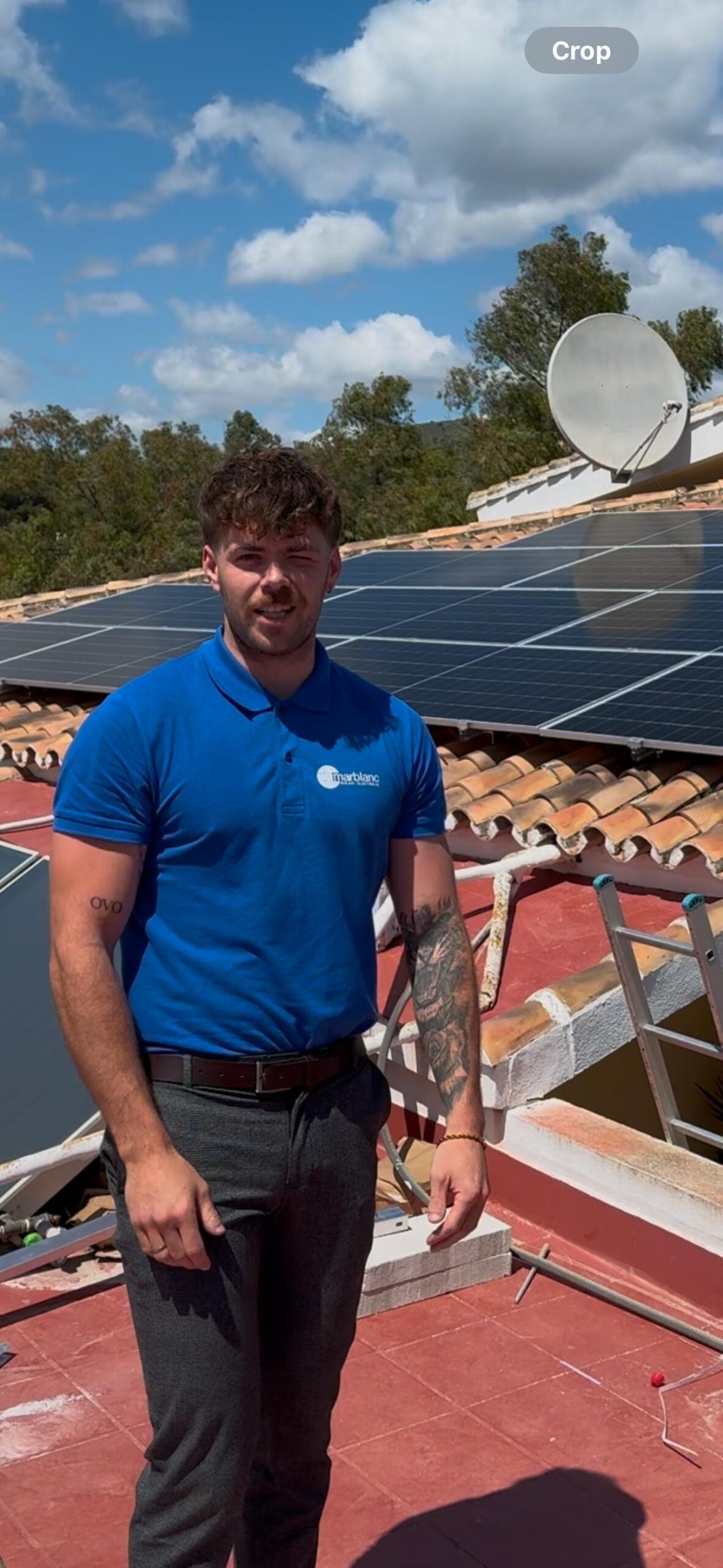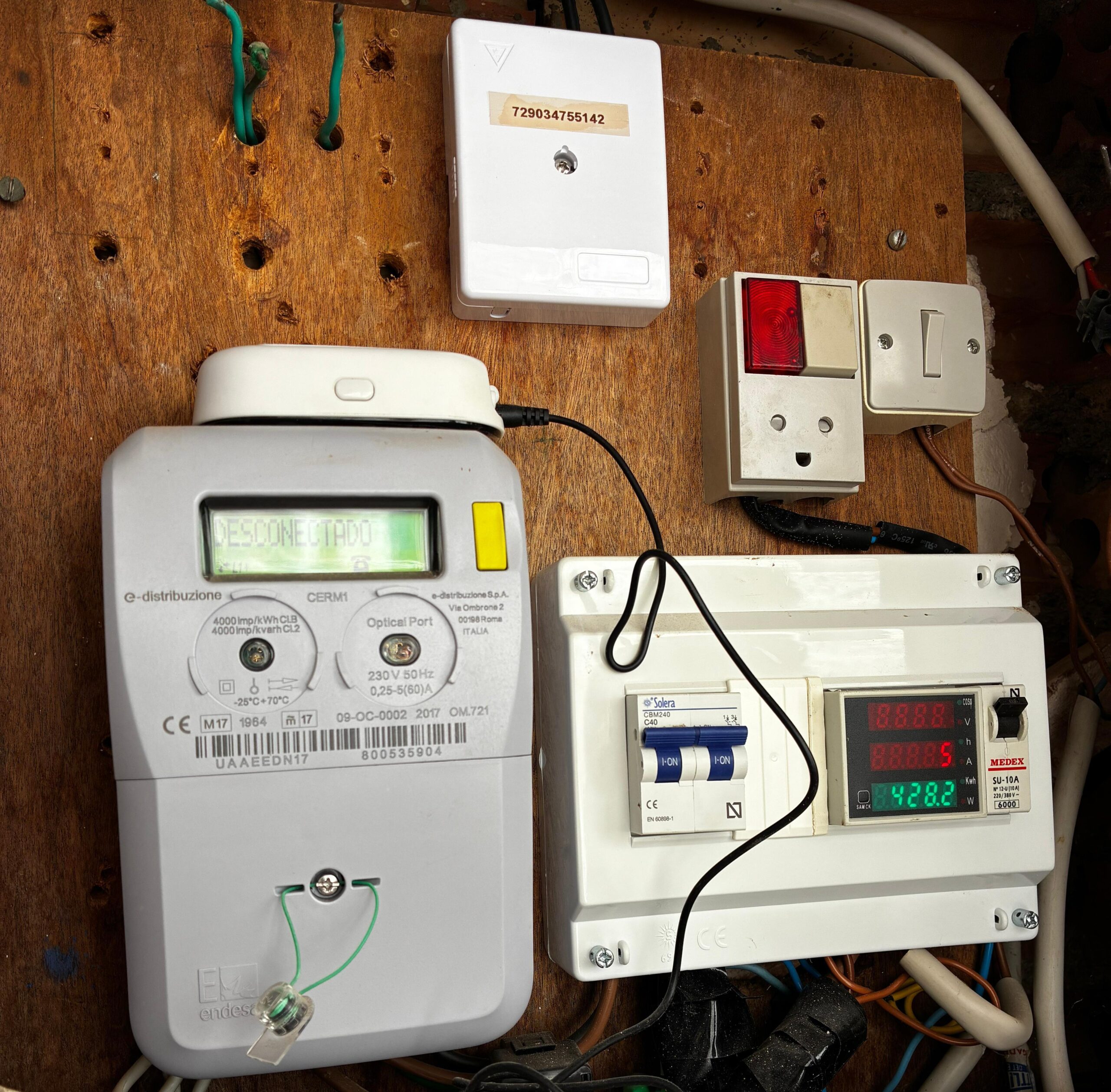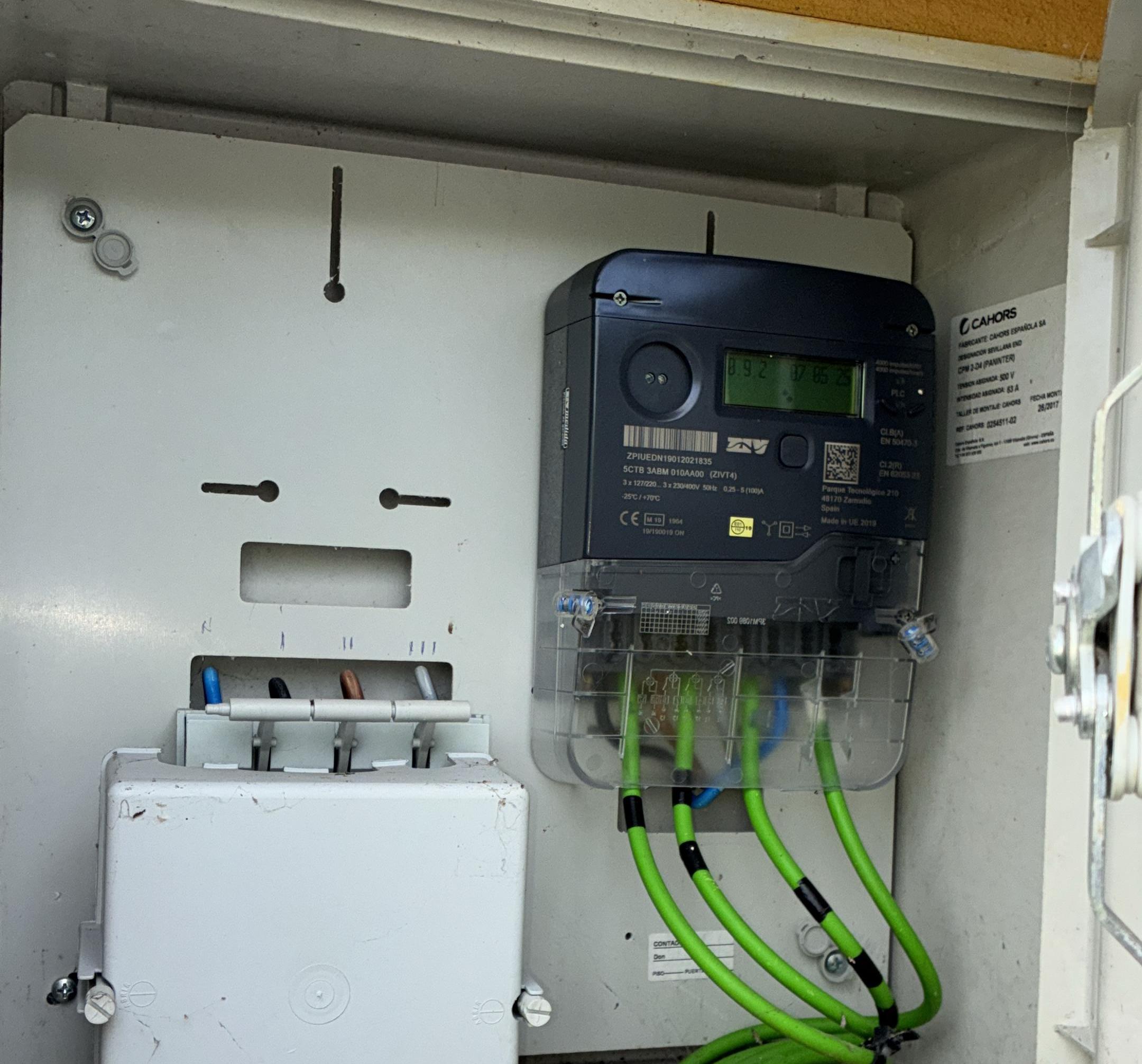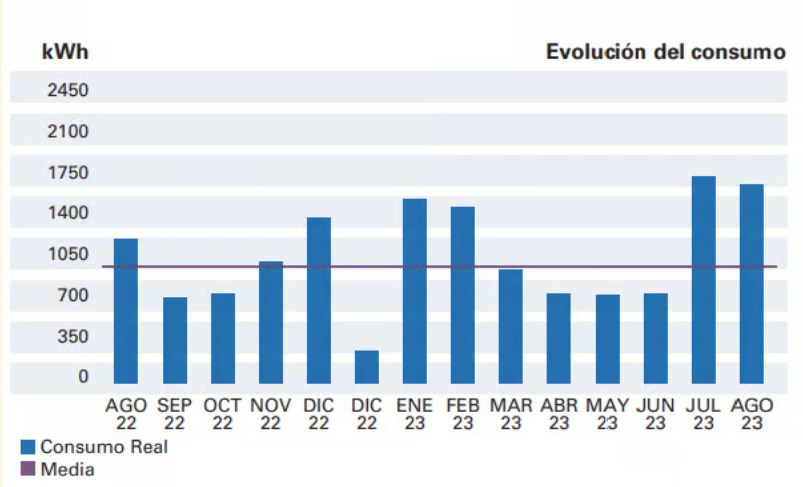
Alan Manning is a survey engineer for Marblanc Solar. He is a fully qualified electrician with a QQI Level 6 Advanced Certificate Craft – Electrical from the Technological University Dublin.
If you look at Facebook Groups about solar energy in Spain, you’ll see the same questions cropping up.
Questions like:
- “I’d like to generate 400 kWh per month. How many panels do I need?”
- “Will 19 east- and west-facing solar panels give the same energy as nine south-facing panels?”
- “Would a 5 kW system on a flat roof (bungalow) be enough to power my kitchen appliances and air-conditioning?”
It’s hard to get a good answer.
With so many factors at play, we always recommend you book in a free solar survey with a survey engineer at Marblanc Solar. If you do, we’ll visit your property with a MacBook and the world’s leading 3D solar design software, called Pylon, so you can see production estimations expected by placing solar panels on different parts of your property.
But in case you’re looking for a shorter answer…
Let me walk you through our three-step process for sizing a solar installation on the Costa del Sol that can cut your electricity bills by 80% or more.
Try the Solar Break-even Calculator
In 1-2 minutes, our online solar calculator will estimate your:
Break-even period
Annual electricity savings for the next 10 years
IBI (property tax) reduction
IRPF (personal income tax) reduction
Click below to get started.
Solar calculatorStep 1: Check if Your Electrical Intake is Single or Three Phase
The first step to sizing your solar system is to figure out what kind of electrical intake your home has: single-phase or three-phase.
Why does it matter?
Because if you have a single-phase intake, the legal limit for a residential solar system is 12 kW. But with three-phase, you can go much bigger, which is essential for large homes, villas or anyone with high energy demands like a pool heater or multiple air-con units.
There are two main ways to check:
- Look inside your fuse board to see the main breaker.
- Open the curbside intake box (where your power connects to the house from the street).
It’s not always obvious, though.
Some homes have a three-phase breaker in the curbside box, but are only wired for single-phase inside. As a survey engineer for Marblanc Solar, I carry a special key to open the curbside intake and confirm exactly what’s going on.
See below for photos of a single-phase fuseboard and a three-phase fuseboard from real homes in Spain, in case you’re keen to take a look.
If you’d like me to look at your fuseboard and curbside intake box, feel free to book in a free solar survey.


Step 2: Figure Out Your Average monthly Consumption
Once we know your intake type, the next step is to understand how much electricity you’re using.
Most Spanish electricity providers – like Endesa and Iberdrola – make this easy. On every bill, they show your average daily electricity cost over the past 14 months or so. Sometimes it’s broken down by day, sometimes by billing cycle, but either way, it gives us a really solid starting point.
At Marblanc Solar, we use this data in our 3D solar design software to estimate your average monthly consumption and run simulations based on it.
But if you want to do a rough calculation yourself, there’s a way to do it.
Look for the bar chart that shows your monthly kWh usage for the last year. Find the highest and lowest months, then choose a number somewhere in the middle – this gives you a ballpark monthly average.
It’s important to get this right.
That average figure is what we base your solar production targets on. In summer, your system might produce 80–90 kWh per day. But in winter? It could drop to 30 or even 20 kWh, depending on your roof space and orientation. That’s why we always aim to size your system for 70–80% savings across the year, not just the summer months.
See an example below from a real client’s electricity bill.

To try our solar calculator, you only need to input this monthly average consumption figure. Click below to try it out.
Try the Solar Break-even Calculator
In 1-2 minutes, our online solar calculator will estimate your:
Break-even period
Annual electricity savings for the next 10 years
IBI (property tax) reduction
IRPF (personal income tax) reduction
Click below to get started.
Solar calculatorStep 3: Match Panel Layout to Roof Space & Savings Requirement
Here’s where it gets tricky.
The right solar setup doesn’t just depend on your electrical intake or past energy use, it comes down to how well we can match the available space to your ideal savings.
Key questions we look at are:
- How much usable roof (or ground) space do you have?
- What type and wattage of solar panels will you install?
- How much do you want to save on your electricity bill?
Let’s look at each of these questions in turn.

Roof space
For most people, the roof is the main installation area.
If you already know the exact square meters available on your south-facing roof sections, then that’s perfect.
But most homes have their available space split across different roof sections, each with their own tilt and orientation. In some cases, clients have a pergola, garage, or garden space that needs to be used. For these reasons, we use Pylon software to calculate the usable panel space instantly across multiple different roof sections.
There’s something else to consider too.
We find that aesthetics plays an important role for our clients. On some modern villas in the Costa del Sol, we’ve installed panels flat against the roof because the client wanted to keep a clean, low-profile look, or needed to comply with local building rules.
Fitting panels flat means a slight reduction in production, usually by 5-10%.
All of these details matter, and they’re why we recommend using accurate software and getting expert advice.

Solar Panel Output
Not all solar panels are created equal.
We typically use 565 W panels, which are at the higher end of what’s available today. That means we can squeeze more production from less surface area, which is especially important on tight or split-roof setups.
Using our software, we place the panels virtually on your property and get instant feedback in terms of estimated daily, monthly and annual production.
We can also run different layouts and adjust the system to suit your space and energy needs.
If you’re trying to do a rough estimate yourself, here’s a quick tip:
In the Costa del Sol, the average number of peak solar hours per day is six.
So a 5 kW system = roughly 30 kWh/ day = ~900 kWh/ month.
Here’s a quick breakdown of how you might use this information, if you know how much south-facing roof space you have and are using 565 W panels.
- First, work out how many panels will fit on your roof section
A typical 565 W panel takes up around 2 m² so, with 20 m² of space, you can fit about 10 panels - Multiply the number of panels by the power rating
10 panels x 565 W = a total system size of 5.65kW - Figure out the average daily peak solar hours
Marbella gets around six peak sun hours per day on average across the year - Multiply your system size by the number of sun hours
5.65 kW x 6 hours = roughly 33.9 kWh of electricity generated per day - To find the monthly production, multiply that by 30.
That gives you around 1,017 kWh per month. - To find the annual production, multiply that by 12.
Over the course of a year, that adds up to about 12,204 kWh.
Let’s imagine you currently pay €0.25 per kWh, the above calculation will see you saving over €3,051 on electricity a year from 20 m² of good-quality roof space.
Of course, that’s a very basic estimate and doesn’t account for seasonal variation, shading or orientation – for instance, a west- or east-facing roof will produce less than a south-facing one – and this needs to be factored in.

Ideal savings
Once we’ve estimated your expected solar production, the final step is translating that into savings.
Let’s say you use around 800 kWh per month and your electricity provider charges you €0.25/ kWh. That’s a monthly bill of €200.
Here’s a quick example of how you can work backwards to figure out how many solar panels and how much roof space you need:
- Let’s say your monthly electricity use is 800 kWh.
To save 80%, you’d need your solar system to produce about 640 kWh/ month. - Divide that by 30 to get your average daily production target.
640/ 30 = ~21.3 kWh/ day - Marbella averages around six peak sun hours/ day, so divide by six to find the system size needed.
21.3/ 6 = ~3.55 kW system required - Now figure out how many panels that means
If each panel is 565 W (0.565 kW), then: 3.55/ 0.565 = ~7 panels - Then work out the space needed
7 x 2 = 14 m² of usable roof space needed
Savings give us a clear target for system sizing, but this needs to match this up with the available roof space and the solar panel output.

Do I really Need an Installer to Size my system?
It’s a fair question and one I get a lot.
In this article, I’ve shared some rough guidelines to help you estimate your system size based on your usage, number of sun hours and roof space. And, if you’re the kind of person who likes to run the numbers, that’s a great start.
But sizing a solar system properly is complex.
When we use professional software like Pylon, we’re not just dropping panels onto a roof outline, the software matches up your available surface area with panel size, wattage, orientation, tilt angle and your target savings. This gives us a powerful base to work from.
But even that isn’t perfect.
Software can’t always account for real-world issues, like shading from chimneys, trees or neighbouring buildings. It also might not tell you that a north-facing roof or a balcony wall is a poor place to install.
Why Marblanc Solar Sends a Survey Engineer, not a Salesperson
I’ve heard from a lot of clients who felt lost after getting quotes from other solar companies.
In many cases, they’d only met with salespeople. They were handed a proposal without really understanding how it was put together, or whether it was right for their property.
That’s why at Marblanc Solar, we do things differently.
We send qualified electricians and survey engineers, like myself, to your home. I walk you through how the whole system works, answer your questions, and give you real-world examples from hundreds of solar installations in the Costa del Sol.
The combination of software accuracy and experience is the best way to size your system for the long-term savings you’re aiming for.
Get a Free Solar Survey From Marblanc Solar
At Marblanc Solar, we believe in doing things transparently.
That’s why we offer a completely free, no-obligation solar survey to any homeowner considering solar in Marbella, or anywhere on the Costa del Sol.
When you book a survey, someone like me (a qualified electrician) will visit your home in person. I’ll carry out a full inspection of your roof, using an aerial drone to assess the health of your roof and any available space.
Once I’ve completed an analysis back at the office, I’ll return for a second visit with two or more system proposals. With a MacBook, I’ll walk you through each proposal, using our professional design software (Pylon), showing you how your installation costs and long-term savings are affected by things like:
- Adding or removing panels
- Switching roof sections
- Including a battery
You’ll see everything clearly – no guesswork, no vague estimates.
We’ll then generate an instant, itemised quote on-site, using our software, and will send it to you before we even get in the car to leave; no waiting days or weeks (like with many companies in Spain).
This survey is 100% free, with no obligation to proceed. It’s simply designed to give you the information you need to make a confident, informed decision about whether solar is right for your home.
Ready to see what’s possible?
Schedule your free solar survey
The free solar survey includes: home visit, drone inspection, 3D shading analysis, savings estimation and custom proposal. Fill out the form and we’ll get back within one working day.
Free solar survey
